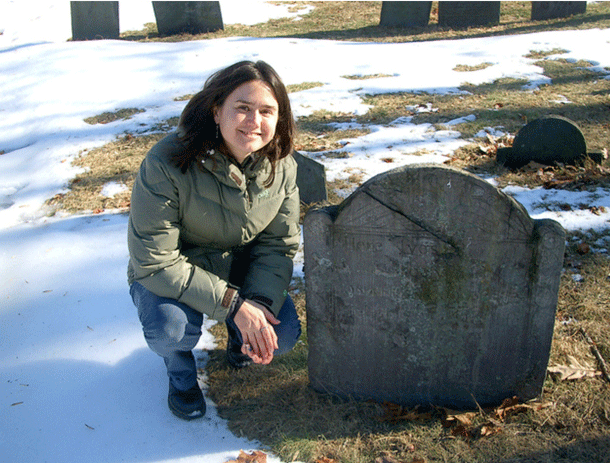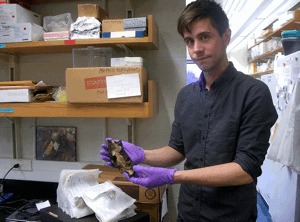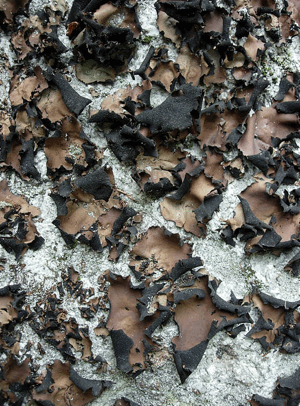We Like Lichen
Air Date: Week of March 11, 2011

Anne Pringle at a local cemetery in Cambridge, MA. (EOL Learning and Education Group)
Lichens are all around us— they grow on rocks, trees, fences. The fungi are intricate bacterial communities made up of multiple species. Producer Ari Daniel Shapiro looked at some of the fungi with a couple of Harvard scientists who are examining lichen ecosystems and how they react to changes in climate and pollution.
Transcript
GELLERMAN: In the first stanza of his poem “Auguries of Innocence,” William Blake writes an ode to the ordinary and asks us to open our eyes to the miracles lying right before us. It begins:
“To see a world in a grain of sand,
and a heaven in a wild flower,
Hold infinity in the palm of your hand,
And eternity in an hour.”
With Blake's rhyme and verse in mind, reporter Ari Daniel Shapiro tracked down a couple of biologists who are taking the Romantic poet at his word.
[CARS HONKING]
SHAPIRO: In the heart of Cambridge, Massachusetts - in bustling Harvard Square - there's a small cemetery called the Old Burying Ground. Twelve hundred historic tombstones huddle inside, including a handful of local Revolutionary War heroes.

Anne Pringle at a local cemetery in Cambridge, MA. (EOL Learning and Education Group)
PRINGLE: You can see it here, 1765.
SHAPIRO: Anne Pringle is an Associate Professor at Harvard. And this isn't her first time walking through this snow-covered cemetery.
PRINGLE: The funniest comment I ever got was somebody”¦somebody who thought that I was mourning, and they were wondering why I was mourning for so very long on my hands and knees in front of a particular tombstone.
SHAPIRO: And what were you doing in fact?
PRINGLE: I was counting lichens.
SHAPIRO: Pringle's a mycologist. That is: she studies fungi. And lichens are a special type of fungus. They're often first to colonize new habitats, and they can grow on tree bark, fence posts, and stones, including tombstones like the ones in this cemetery. But, that's not all.
[PAPER PACKET CRUMPLING]
SHAPIRO: Back in her office, Pringle unfolds a paper packet containing a kind of lichen called Xanthoparmelia plittii. She points out the tiny, crusty swirls the color of spearmint.
PRINGLE: Lichens are symbioses - that means that they are made up of multiple species living together. And generally, a lichen is one individual fungus, and living inside, embedded in the matrix of that fungus, there are algae, and maybe more than one species of algae.

Examining lichen on a gravestone. (EOL Learning and Education Group)
SHAPIRO: It's a complicated organism. A lichen is a fungus with algae living inside it. The algae photosynthesize, converting carbon dioxide into sugars - food that the fungus can consume. It's not clear whether the algae get anything out of the arrangement, except maybe a home they wouldn't otherwise have.
PRINGLE: What's also interesting about a lichen is realizing that it's an entire habitat for other creatures inside it: of bacteria, of other fungi. So, when you look at a lichen, when you're walking by, it's not just an individual - it's an entire ecosystem, sort of like a tropical rainforest in miniature, just maybe the size of the palm of your hand growing on a fencepost.
SHAPIRO: Within the lichen, how many species are there - of the bacteria, the fungi, the algae?
PRINGLE: Oh, I don't know. Hundreds, order of magnitude.
[DOOR OPENING]
SHAPIRO: Next door, in Pringle's lab, mycologist Benjamin Wolfe holds up what looks like a giant black potato chip the size of his hand. This lichen's a different species - Umbilicaria mammulata - but the story”¦it's the same.

Mycologist Benjamin Wolfe holds up a lichen called Umbilicaria mammulata. (EOL Learning and Education Group)
WOLFE: So if you look on the back of it, you see it's, like, this very rough, velvety, kind of surface. If you touch it, yeah”¦
[VELVET RUBBING SOUND]
WOLFE: Those little nooks and crannies are great places for bacteria to live. And I've done a little bit of work using these high-powered microscopes to zoom in on the back of these and you see these huge microbial landscapes - little bacterial gardens nestled into this forest of these underbellies of the lichens. So it's, sort of, this idea of a world within a world.
SHAPIRO: Unlike other types of fungi that live pretty much concealed inside trees or in the dirt, lichens - these worlds within worlds - are exposed entirely to the elements.
[TRAFFIC SOUNDS]
SHAPIRO: So at a place like the Old Burying Ground in Cambridge, the lichens dotting the tombstones have to handle whatever the environment throws their way. Usually, lichens do really well, but not always. Anne Pringle:
PRINGLE: Here in a cemetery, there used to be a thriving community of lichens, and now there isn't because of the pollution that humans have created. When we walk into a cemetery in rural Massachusetts, it's a very different landscape. The tombstones are covered in green. They're covered in very beautiful leaf-like lichens. It's an entire world that just has disappeared from this local habitat.

Umbilicaria growing on a rock in Maine. (EOL Learning and Education Group)
SHAPIRO: Pringle is comparing the lichens in urban and rural settings - to see how long they live, and how they grow and reproduce. She can use this information to think about how fungi more generally might react to changes in climate and pollution, and what that might mean for entire ecosystems - both the little ones living on and in the fungi, and the big ones that depend on fungi as decomposers. For Living on Earth, I'm Ari Daniel Shapiro.
GELLERMAN: Ari Daniel Shapiro's story comes to us from the series “One Species at a Time,” which is produced by Atlantic Public Media with support from the Encyclopedia of Life. For more information, go to our website l-o-e dot org. And there you'll find some photos of lichens and a link where you can post some of your own pictures.
GELLERMAN: Coming up - Hollywood rolls out the red carpet for a green future. Stay tuned to Living on Earth!
Links
To see photos of lichen and to post your own, go the Lichen episode of Encyclopedia of Life podcast
Living on Earth wants to hear from you!
Living on Earth
62 Calef Highway, Suite 212
Lee, NH 03861
Telephone: 617-287-4121
E-mail: comments@loe.org
Newsletter [Click here]
Donate to Living on Earth!
Living on Earth is an independent media program and relies entirely on contributions from listeners and institutions supporting public service. Please donate now to preserve an independent environmental voice.
NewsletterLiving on Earth offers a weekly delivery of the show's rundown to your mailbox. Sign up for our newsletter today!
 Sailors For The Sea: Be the change you want to sea.
Sailors For The Sea: Be the change you want to sea.
 The Grantham Foundation for the Protection of the Environment: Committed to protecting and improving the health of the global environment.
The Grantham Foundation for the Protection of the Environment: Committed to protecting and improving the health of the global environment.
 Contribute to Living on Earth and receive, as our gift to you, an archival print of one of Mark Seth Lender's extraordinary wildlife photographs. Follow the link to see Mark's current collection of photographs.
Contribute to Living on Earth and receive, as our gift to you, an archival print of one of Mark Seth Lender's extraordinary wildlife photographs. Follow the link to see Mark's current collection of photographs.
 Buy a signed copy of Mark Seth Lender's book Smeagull the Seagull & support Living on Earth
Buy a signed copy of Mark Seth Lender's book Smeagull the Seagull & support Living on Earth

